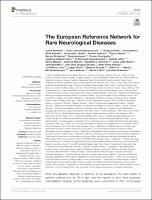| dc.contributor | Vall d'Hebron Barcelona Hospital Campus |
| dc.contributor.author | Reinhard, Carola |
| dc.contributor.author | Bachoud-Lévi, Anne-Catherine |
| dc.contributor.author | Bäumer, Tobias |
| dc.contributor.author | Bertini, Enrico |
| dc.contributor.author | Brunelle, Alicia |
| dc.contributor.author | Buizer, Annemieke |
| dc.contributor.author | Macaya Ruíz, Alfons |
| dc.contributor.author | Perez Dueñas, Belen |
| dc.date.accessioned | 2022-06-08T08:55:30Z |
| dc.date.available | 2022-06-08T08:55:30Z |
| dc.date.issued | 2021-01 |
| dc.identifier.citation | Reinhard C, Bachoud-Lévi AC, Bäumer T, Bertini E, Brunelle A, Buizer AI, et al. The European Reference Network for Rare Neurological Diseases. Front Neurol. 2021 Jan;11:616569. |
| dc.identifier.issn | 1664-2295 |
| dc.identifier.uri | https://hdl.handle.net/11351/7638 |
| dc.description | Xarxa europea de referència; Malalties neurològiques rares; Assistència sanitària virtual |
| dc.description.sponsorship | This work is generated within the European Reference Network for Rare Neurological Diseases—Project ID No. 739510. |
| dc.language.iso | eng |
| dc.publisher | Frontiers Media |
| dc.relation.ispartofseries | Frontiers in Neurology;11 |
| dc.rights | Attribution 4.0 International |
| dc.rights.uri | http://creativecommons.org/licenses/by/4.0/ |
| dc.source | Scientia |
| dc.subject | Malalties rares - Diagnòstic |
| dc.subject | Telemedicina |
| dc.subject | Neurologia pediàtrica |
| dc.subject.mesh | Rare Diseases |
| dc.subject.mesh | Nervous System Diseases |
| dc.subject.mesh | Telemedicine |
| dc.title | The European Reference Network for Rare Neurological Diseases |
| dc.type | info:eu-repo/semantics/article |
| dc.identifier.doi | 10.3389/fneur.2020.616569 |
| dc.subject.decs | enfermedades raras |
| dc.subject.decs | enfermedades del sistema nervioso |
| dc.subject.decs | telemedicina |
| dc.relation.publishversion | https://doi.org/10.3389/fneur.2020.616569 |
| dc.type.version | info:eu-repo/semantics/publishedVersion |
| dc.audience | Professionals |
| dc.contributor.organismes | Institut Català de la Salut |
| dc.contributor.authoraffiliation | [Reinhard C, Brunelle A] Institute for Medical Genetics and Applied Genomics, University of Tübingen, Tübingen, Germany. Centre for Rare Diseases, University Hospital Tübingen, Tübingen, Germany. [Bachoud-Lévi AC] Assistance Publique-Hôpitaux de Paris, National Reference Center for Huntington's Disease, Neurology Department, Henri Mondor-Albert Chenevier Hospital, Créteil, France. Département d'Etudes Cognitives, École normale supérieure, PSL University, Paris, France. Inserm U955, Institut Mondor de Recherche Biomédicale, Equipe E01 NeuroPsychologie Interventionnelle, Créteil, France. [Bäumer T] Institute of Systems Motor Science, University of Lübeck, Lübeck, Germany. Centre for Rare Diseases, University of Lübeck, Lübeck, Germany. [Bertini E] Unit of Neuromuscular and Neurodegenerative Disorders and Genetics and Rare Diseases Research Division, Bambino Gesù Children's Research Hospital, Instituto de Ricovero e Cura a Carattere Scientifico, Rome, Italy. [Buizer AI] Department of Rehabilitation Medicine, Amsterdam Movement Sciences and Emma Children's Hospital, Amsterdam University Medical Centers, Vrije. [Macaya A] Servei de Neurologia Pediàtrica, Vall d'Hebron Institut de Recerca (VHIR), Barcelona, Spain. Institut de Neurociència, Universitat Autònoma de Barcelona, Bellaterra, Spain. [Pérez Dueñas B] Servei de Neurologia Pediàtrica, Vall d’Hebron Hospital Universitari, Barcelona, Spain. Grup de Recerca en Neurologia Pediàtrica, Vall d'Hebron Institut de Recerca (VHIR), Barcelona, Spain, Universitat Autònoma de Barcelona, Bellaterra, Spain |
| dc.identifier.pmid | 33519696 |
| dc.identifier.wos | 000612341500001 |
| dc.rights.accessrights | info:eu-repo/semantics/openAccess |

